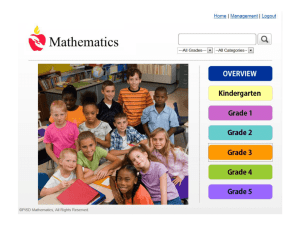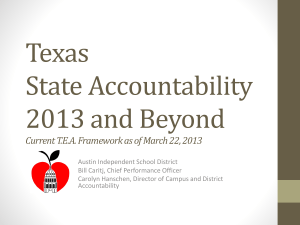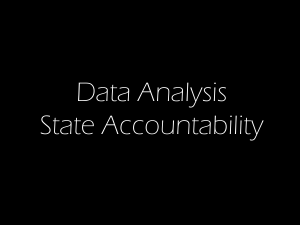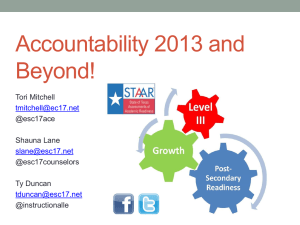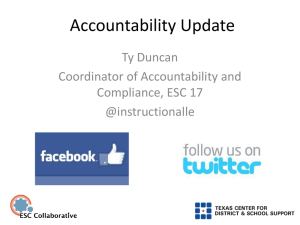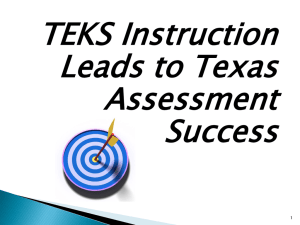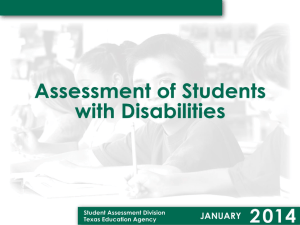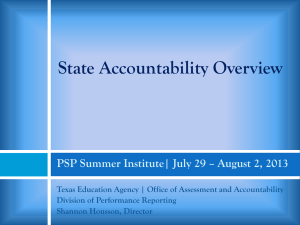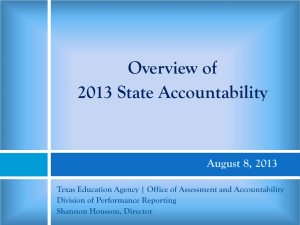Accountability Presentation
advertisement
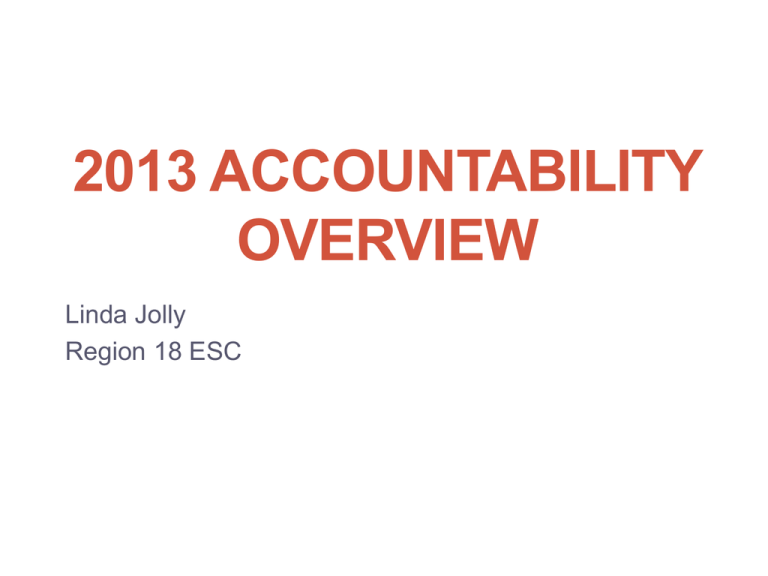
2013 ACCOUNTABILITY OVERVIEW Linda Jolly Region 18 ESC 2 Accountability System Differences 2011 and before 2013 and ?? • % meeting standard • Point based • 25 indicators • Missed 1 = Unacceptable • 4 Index Targets • Miss 1 Target • Not all students counted • All students count • Separate from federal • Integrated with federal 3 Differences • Emphasis now on: • Individual student progress • Closing the gaps • Post-secondary readiness 4 Rating Labels • Met Standard • Met Alternative Standard (for AEA) • Improvement Required • Not Rated (for DAEP, JJAEP,…) 5 Performance Index Framework STAAR/EOC Phase-in of Standards • STAAR Level II passing standards will be phased-in • Phase 1 • Phase 2 • Final standards 2012 and 2013 2014 and 2015 2016 and beyond (final panel-recommended 7 Performance Index Criteria 2013 Rating Labels 2013 Rating Labels: • Met Standard – met performance index targets on all indexes for which they have performance data in 2013. • High Schools – All 4 index targets • Elementary and Middle Schools – All 3 index targets where they have data. • Improvement Required: Did not meet one or more performance index targets. 8 2013 Performance Index Targets To receive a Met Standard Rating all non-AEA campuses and districts must meet the following accountability targets on all indexes for which they have performance data in 2013 Performance Index Campuses Districts Index 1: Student Achievement 50 50 Index 2: Student Progress High Schools – 17 Middle Schools – 29 Elementary - 30 21 Index 3: Closing Performance Gaps 55 55 Index 4: Postsecondary Readiness 75 75 9 2013 Accountability Snapshot The following snapshot table applies to Index 1, 2, and 3: 10 STAAR Phase-in Final and Recommended Level II and Level III Standards TEA proposal change is to maintain Phase 1 for the 2013-2014 school year for all assessments 11 2013 Accountability Summary 12 2013 Accountability Summary 13 Index 1: Student Achievement Index 1: The purpose of this index is to provide a snapshot of performance across all subjects at the satisfactory performance standard (Phase-in I Level II). • Subjects: Combined over Reading, Mathematics, Writing, Science and Social Studies. • Student Groups: All Students only 14 Index 1: Student Achievement • Performance Standards: Phase-in I Level II Standard (Satisfactory) on the following assessments: • STAAR Grades 3-8 English and Spanish (3-5) Spring 2013 • EOC Assessments (best results: highest score) Spring 2013, Fall 2012, and Summer July 2012 • STAAR Grades 3-8 and EOC Modified for Spring 2013 • 2013 only: TAKS, TAKS Accommodated and TAKS-Modified • Grade 11 Results at Met Standard Performance • Primary Administration only • 2014 and beyond will not include TAKS 15 Index 1: Region 18 TARGET = 50 Level I – Not Met Standard/Unsatisfactory Academic Performance Level II - Met Standard /Satisfactory Performance Level III – Advanced Academic Performance/ 16 Index 1: Region 18 Student Achievement Data Table 17 Index 1: Region 18 Sample Student Achievement Data Table 18 Index 2: Student Progress Index 2: Student Progress focuses on actual student growth independent of overall student achievement levels. • Subjects: Reading, Mathematics, and Writing in available grades • Ten Student Groups Evaluated: • All Students • Students served by Special Education • English Language Learners (ELL) • Seven Racial/Ethnic Groups: African American, American Indian, Asian, Hispanic, Pacific Islander, White, and Two or More Races 19 Index 2: Student Progress • Three Growth Indicators: • Did Not Meet Growth Expectation = 0 • Met Growth Expectation = 1 • Exceeded Growth Expectation = 2 High Schools = 17 Middle Schools = 29 Elementary = 30 AEA = 9 • Credit based on weighted performance: • One point credit given for each percentage of tests at Met Growth expectations level. • Two points credit given for each percentage of tests at the Exceeded growth expectations level. # of points = Points earned # of tests 20 Index 2: Student Progress Calculation Report Region18 21 Index 2: Student Progress Calculation Report Region 18 22 Index 2: Student Progress Calculation Report Region 18 23 Index 3: Closing Performance Gaps Index 3: Closing Performance Gaps emphasizes advanced academic achievement of economically disadvantaged students and the two lowest performing race/ethnicity students groups. • Subject Area: Reading, Mathematics, Writing, Science and Social Studies • Student Groups: • Economically Disadvantaged • Lowest Performing Race/Ethnicity: Two lowest performing race/ethnicity student groups on the campus or district (based on prior-year assessment results) Sub Pop 1 and 2 are determined as the lowest performing from 2012 results. ELLS are excluded 24 Index 3: Closing Performance Gaps Credit based on weighted performance: • Phase-in Level II satisfactory performance -2013 and beyond • One Point for each percent of students at the Phase-in Level II satisfactory performance standard. • Level III Advanced performance – 2014 and beyond • Two points for each percent of students at the Level III advanced performance standard. 25 Index 3: Closing Performance Gaps Calculation Report Region 18 26 Index 3: Closing Performance Gaps Calculation Report Region 18 27 Index 3: Closing Performance Gaps Data Table Region 18 Here is your 2012 STAAR results that determines your 2 sub pops 28 Index 3: Closing Performance Gaps Data Table Region 18 29 Index 4: Postsecondary Readiness Index 4: Postsecondary Readiness emphasizes the importance for students to receive a high school diploma that provides them with the foundation necessary for success in college, the workforce, job training programs, or the military; and the role of elementary and middle schools in preparing students for high school. 30 Index 4: Postsecondary Readiness Graduation Score: Combined performance across the graduation rates from either the 4 year or 5 year graduation rates and the Diploma Indicator: • Grades 9-12 Four-Year Graduation Rate for All Students and all student groups or Grades 9-12 Five-Year Graduation Rate for All Students and all student groups, whichever contributes the higher number of points to the index • RHSP/DAP Graduates for All Students, ELL, Special Ed, and 7 race/ethnicity student groups (Diploma Plan Indicator) 31 Index 4: Postsecondary Readiness STAAR Score: • STAAR Percent Met Final Level II on One or More Tests for All Students and race/ethnicity student groups (2014 and beyond) • Subjects: Reading, Writing, Math, Science and Social Studies • Student groups: All students and 7 race/ethnicity student groups: African. Am., Am. Indian, Asian, Hispanic, Pacific Islander, White, Two or more races. • Minimum size criteria: All students – none, small analysis if fewer than 10. Student groups >=25 32 Index 4: Post Secondary Readiness Calculation Report Region 18 4yr Grads (2012) 5yr Grads (2011) # of RHSP/ DAP (2012) # of Grads (2012) Score Score 33 Index 4: Postsecondary Readiness Data Table Region 18 Emphasis on this index is the importance of students to receive a hs diploma that provides them with the foundation for success in college, workforce, job training, or military. 34 System Safeguards • With the PI (Performance Index) framework, poor performance in one subject or one student group does not result in an Improvement Required Rating. • However, districts and campuses are responsible for addressing performance for each subject and each student group. • System safeguards are added to ensure that poor performance in one area or one student group is not masked in the performance index. • Participation rates, graduation rates, and limits on use of STAAR Alternate and STAAR Modified are calculated to meet federal requirements. • Texas Accountability Intervention System (TAIS) 35 System Safeguards Region 18 Failure to meet the safeguard target for any reported cell must be addressed in the CIP/DIP. 36 Distinction Designations • Campuses that receive an accountability rating of Met Standard are eligible for Distinction Designation Campus Designations awarded: • Top 25% Student Progress – based on performance on Index 2: Student Progress. Campuses that are in the top quartile of their campus comparison group (40 campuses) • Academic Achievement in Reading/ELA – outstanding academic achievement in Reading/ELA on a variety of indicators • Academic Achievement in Mathematics – outstanding academic performance in Math on a variety of indicators. 37 Top 25% Student Progress Distinction • Campuses in the top 25% (top 10 in group) of their campus comparison group (40 campuses) on Index 2: Student Progress score are eligible for a distinction designation for student progress. • Campuses only • Eligibility criteria – Met Standard rating • Campuses in the top 25% in student progress • Campus comparison groups set by TEA based on campus similarities 38 Academic Achievement Distinction Designations • Distinction Designation Indicators • Twenty-two indicators will be used to determine outstanding academic achievement and will vary by type of campus and by subject. • Indicators evaluated include performance at the STAAR Level III (Advanced) standard for selecting grades and subject areas in elementary and middle schools, and indicators including SAT/ACT and AP/IB participation and performance for high schools. 39 2013 Academic Achievement Distinction Designations (AADD) Indicators 40 Looking at what is ahead… 2014 ACCOUNTABILITY 41 STAAR Assessments for 2014 HB 5 • STAAR Continues to test for Grades 3-8 • Mathematics at grades 3-8 • Reading at grades 3-8 • Writing at grades 4 and 7 • Science at grades 5 and 8 • Social Studies at grade 8 42 STAAR Assessments for 2014 HB 5 • STAAR EOC Assessments required to pass for high school graduation: • English I (reading and writing combined) • English II (reading and writing combined ) • Algebra I • Biology • U.S. History (Cohort 2011/2012 and Thereafter) 43 STAAR Assessments for 2014 HB 5 • EOC Assessments no longer required or available: • Geometry • Algebra II • Chemistry • Physics • World Geography • World History • English III 44 STAAR Assessments for 2014 HB 5 • STAAR EOC Assessments no longer include: • A cumulative score requirement for graduation. • A minimum score to count towards the cumulative score. • The requirement that the score count as 15% of the final course grade. STAAR Assessments for 2014 HB 5 45 • STAAR EOC Assessments Requirements: • The commissioner is required to provide a scale score to 100-point score conversion table. • Districts are required to provide accelerated instruction to students EACH time a student fails any of the five STAAR EOC assessments in the applicable subject area prior to the next administration of the test. • District shall use funds appropriated for AI (accelerated instruction), and must provide the AI at no cost to student. • District must evaluate the effectiveness of all AI programs for EOCs and annually hold a public meeting to consider the results. 46 STAAR Assessments for 2014 HB 5 • STAAR English I and II: • Instead of having separate reading and writing assessments, these tests will be combined into one assessment per course with one score. • The combined assessments will be available beginning in spring 2014. 47 Release of STAAR Assessments HB 5 • Requires the agency to release the general STAAR assessments for grades 3-8 and EOC (first spring form only) and STAAR Spanish assessments for grades 3-5 (first spring form only) in: • 2012-2013, 2013-2014, 2014-2015, 2015-2016 • Requires the agency to release STAAR Modified for grades 3-8 and EOC (first spring form only) in: • 2013-2014, 2014-2015, 2015-2016 • Requires the agency to release the general STAAR, STAAR Spanish, and STAAR Modified every third year thereafter. Other Assessment Changes HB 5 48 • Requires the commissioner to establish assessment administration procedures that minimize disruptions to school operations and classroom environments. • Prohibits districts from removing students from class for remedial tutoring or test preparation for more than 10% of the school year (parent permission exception). • Limits the number of benchmark assessments to two per state assessment (does not apply to college preparation assessments such as AP, IB, SAT, ACT). Parents of students with special needs may request additional assessments. • A student is not considered to be enrolled in a U.S. school for a school year unless he/she is enrolled for a period of at least 60 consecutive days. 49 Accountability Changes for 2014 • Each district must annually evaluate district and campus performance in community and student engagement and assign a performance rating of Exemplary, Recognized, Acceptable or Unacceptable. Required measures to be evaluated: • Fine Arts • Wellness & PE • Community and parental involvement • 21st Century Workforce Development • Second Language Acquisition • Digital Learning • Dropout Prevention Strategies • Educational programs for G/T students • Record of the district and campus in complying with statutory reporting and policy requirements Each district will use criteria developed by a local committee and will report ratings to TEA and make ratings publicly available by August 8th of each year. 50 Accountability Changes for 2014 HB5 Distinction Designation TEA shall issue district and campus distinction designations with district/campus ratings by August 8th each year (in connection with performance ratings). District and campus distinction designations shall be awarded for outstanding performance in attainment of postsecondary readiness and MUST include, as newly added factors, the % of students who: • • • • Earned a nationally or internationally recognized business or industry certification or license Completed a coherent scope and sequence of CTE courses Completed a dual credit course or an articulated postsecondary course Achieved applicable college readiness benchmarks or the equivalent on PSAT, SAT, ACT, or ACT Plan • Received a score on AP or IB assessments sufficient to be awarded college credit. • Campus-only distinction designations remain largely unchanged(top 25% for annual improvement in student progress, top 25% in closing student achievement differentials, outstanding performance in ELA, Math, Science or Social Studies, outstanding performance in advanced middle or junior high school achievement) BUT distinctions on fine arts, PE, 21st Century Workforce, and second language acquisition have been removed from TEA’s domain and moved to the district level. 51 Additional Student Achievement Indicators Required HB5 • % of students completing distinguished level of achievement under foundation high school program • % of students completing an endorsement • At least 3 additional indicators which MUST include: • % of students satisfying TSI in reading, writing, or math • # of students earning 12 hours of postsecondary credit required for foundation program or to earn an endorsement • # of students earning >30 hours of postsecondary credit required for foundation program or to earn an endorsement • # of students earning associate’s degree • # of students earning an industry endorsement • An indicator that measures improvements in student achievement cannot negatively affect TEA’s review of a district/campus if the district/campus is already achieving at the highest level 52 Additional Student Achievement Indicators Required HB5 • TEA required to determine a way to include in district/campus ratings students who satisfy, before graduation, TSI requirements on college readiness benchmarks prescribed by THEB or passing EOCs • TEA shall, to the greatest extent possible, evaluate campus performance on the basis of factors other than student achievement • Texas School Accountability Dashboard to be developed by TEA for public access to district and campus accountability information; no specified effective date. 53 ANY QUESTIONS? Thank you!!!
